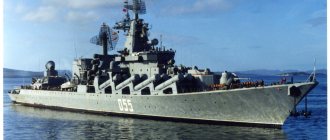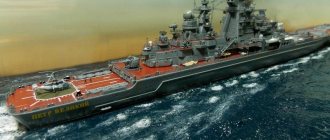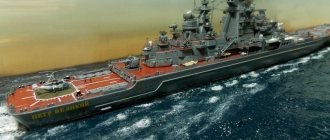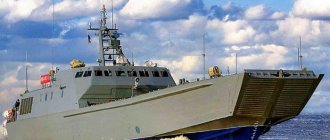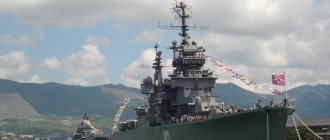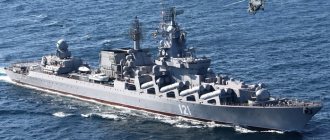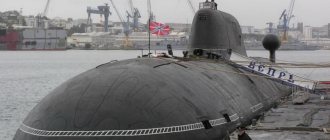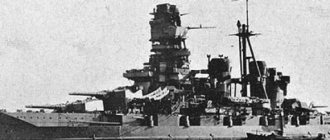Many people know that the Northern Fleet is considered the most powerful in the Russian naval forces. The heavy cruiser Pyotr Velikiy and the aircraft carrier Admiral Kuznetsov serve here. The service of the missile cruiser Marshal Ustinov is also associated with the Northern Fleet; it was its flagship until the commissioning of Petra.
The missile cruiser “Marshal Ustinov” was built according to project 1164 “Atlant”; it played an important role in maintaining the combat capability of the Russian fleet during difficult times for the state’s economy. At the end of the 20th century, the Atlantas were considered the largest and strongest Russian ships in combat service.
Background
By 1970, the surface forces of the USSR Navy consisted mainly of anti-submarine ships. The exception was the Project 58 missile cruisers. However, there were few of them, and they did not pose a significant threat to the growing US aircraft carrier fleet. To correct this situation, designers began work on a new missile cruiser that could destroy any enemy ships, and at the same time would be cheaper to build and operate than the huge nuclear-powered ships of the Orlan project.
The cruisers under development received project number 1164 and the code “Atlant”. The lead ship, Slava, was laid down in Nikolaev in 1976. The next one, Fleet Admiral Lobov, began construction in 1978. This ship will later become the “Marshal Ustinov”.
Description of the design of the Project 1164 cruiser
According to the design of the cruiser, Project 1164, these are long-deck ships with a developed three-island superstructure, pyramidal tower-like foremasts and mainmasts. To improve the seaworthiness and stability of the missile cruiser, the hull frames have a strong camber, and the stem has a strong slope. Throughout the cruiser there is a double bottom (where the fuel tanks are located). The main ammunition cellars are located throughout the cruiser, separated by bulkheads and equipped with irrigation and flooding systems. These measures are aimed at ensuring the unsinkability and survivability of the ship and ensure the unsinkability of the vessel when any 3 compartments are flooded, except for the engine rooms. The cruiser has a complex of protection in physical fields, as well as local structural protection in the area of ammunition magazines, combat posts and command post.
In the first compartment of the ship, along the forward collision bulkhead, there are storerooms and auxiliary rooms. In the second compartment, below the waterline, there is a fence for the Platina hydroacoustic station, above the waterline there is a capstan, a chain box and storerooms. The third compartment of the ship is almost completely occupied by the turret compartment and magazines for the 130-mm artillery mount, as well as combat posts and ventilators. The fourth compartment of the cruiser is reserved for cabins and cockpits with utility rooms in the hold. In the fifth compartment, in addition to living quarters, there is an ammunition cellar for depth charges. In the sixth compartment of the cruiser there is a BIUS, a combat information center, which is connected to the conning tower by a special command elevator. The seventh compartment contains the cruiser's auxiliary mechanisms. The eighth compartment contains the bow engine room with gearboxes, propulsion turbines, TUK and auxiliary steam turbines installed on a common ramp. The ninth compartment houses auxiliary mechanisms.
The tenth compartment contains the aft engine room with afterburner turbines. In the eleventh compartment there are again auxiliary mechanisms. In the twelfth compartment there are under-deck cellars of the Fort air defense system with missile launch drums, a freight elevator and drives and cellars for the PK-2 jamming system (on each side). In compartments 13 and 14 there are crew quarters, service and auxiliary rooms, and the cruiser's torpedo tubes. In the area of 300-310 frames there are cellars and launchers for the Osa air defense system. The aft compartment of the cruiser is mainly used for storing the towed antenna device and systems for its installation and lifting; the afterpeak (ballast tank) is also fenced off here.
Along with steel, aluminum alloys are also used in the ship's design. Elements of the cruiser's superstructure in areas exposed to open flame are made of steel, while the upper structures are made of aluminum alloys for lightness. On the lower tiers there are cabins for senior officers, a wardroom and a flagship command post. The ship's superstructure blocks have technological cuts so that they are not included in the overall strength of the ship's hull and do not crack due to bending stresses. The cruiser's advanced chimneys have air intake systems and are located across the cruiser. Immediately behind them is a crane with a lifting capacity of 8.5 tons.
On the main deck in the aft part, in the form of a separate island, there is a helicopter hangar, which is crowned with a large 30-ton antenna of the Fort air defense system, then in the stern there is a helipad with landing and take-off support systems. In addition to a set of rescue equipment, the ship has a work boat, Project 1402, and a traveling command boat, Project 1404.
The gas turbine installation of a missile cruiser consists of 2 M-21 units, each of which includes 2 afterburning (or main) gas turbine reversible engines that operate on a mating one-way gearbox, as well as 1 main gas turbine reversible engine that operates on a two-speed gearbox The afterburning engines are located in the aft engine room with single-stage shock absorption, while the main engines are located in the bow engine room and have two-stage shock absorption.
The gearboxes of the two afterburners and the main gas turbine engine are connected to the same shaft line using non-disconnectable soundproof couplings. The gas turbine engine is controlled from a central control station using a mechanical system. The heat of the exhaust gases (approximately 400°C) is removed using a heat recovery circuit - TUK and then supplied to special steam boilers, which drive additionally mounted steam turbines operating on propeller shafts through a gearbox together with main gas turbine engines, which allows for an increase in the supplied to power shafts from 6400 to 8000 hp. and leads to an increase in the efficiency of the main mechanisms by 12 percent. This is the most combined and complex gas turbine installation used on modern warships.
Design
Already by its appearance and architecture, “Marshal Ustinov” can be identified as a ship designed in the Soviet Union. The long forecastle, strongly inclined stem, pyramid-shaped masts and superstructures with beveled edges indicate its origin. Such contours provide better seaworthiness and reduce radar visibility. The ship's power plant is gas turbines, of which two are propulsion turbines, for cruising, and four afterburners, to ensure maximum speed.
The purpose of the Atlas - the destruction of any ships of a potential enemy - determined the type of its main weapon.
The P-500 Basalt heavy anti-ship missiles were only slightly inferior in capabilities to the Granit that the Orlans were armed with. Since it was impossible to hide the launchers in the hull on the smaller Atlantas, sixteen containers with missiles placed along the sides became the most noticeable detail of the ships' appearance. Including “Marshal Ustinov”.
Installations for launching Fort anti-aircraft missiles, which protect ships from any air targets at long distances, are located below deck, between the smokestacks and the helicopter hangar. Osa missiles, providing short-range defense, are launched from installations on both sides of the hangar.
Artillery weapons are universal, designed both for anti-aircraft fire and for hitting weakly protected surface and ground targets. It consists of a twin 130mm AK-130 artillery mount located in the bow and six 30mm AK-630 automatic cannons. Two of them are located in the bow, in front of the navigation bridge, and two on each side of the central superstructure.
The ship's anti-submarine weapons include two 533mm torpedo tubes, from which missile-torpedoes can also be launched. Two RBU-6000 bomb launchers are located in front of the navigation bridge. A helicopter based on a missile cruiser is also used to combat submarines.
Initially, “Marshal Ustinov” carried the already outdated Ka-25 helicopter; in Russian times it was replaced by a more modern and powerful Ka-27.
After modernizing the ship, the Basalt missiles were replaced with the P-1000 Vulcan. It is possible to replace anti-aircraft missiles with a more modern S-400 complex.
The Vulcan complex was created specifically so that it could easily re-equip ships armed with Basalt. The P-1000 differs from the P-500 in its lightweight design, due to which the firing range is increased.
The weight of the warhead and armor had to be sacrificed, but now the missile can cover a much greater distance while at low altitude and maneuvers better, evading damaging factors.
Specifications
The closest analogue of the Marshal Ustinov in terms of size and displacement is the American missile cruiser Ticonderoga. However, the ships differ quite significantly in purpose. The American cruiser was conceived as a defensive cruiser, protecting aircraft carriers from submarines and aircraft.
The combat missions of the Marshal Ustinov were conceived as directly opposite to the Ticonderoga.
This "Atlant" was supposed to become the main striking force of the squadron, and it was supposed to be covered by carrier-based aircraft. Despite the presence of powerful Fort anti-aircraft missiles, their number on the Atlantas is less than on the nuclear-powered Orlans and less than on the Standard missiles on the Ticonderogas.
In addition, the Aegis radar system on American cruisers can simultaneously fire up to 18 missiles at a target. The Fort's only guidance radar could simultaneously guide only two missiles onto one target. The outdated Igla installations were also criticized.
Of greater interest is the comparison with the newest destroyer of the US Navy, Zamvolt. Although it is considered a destroyer, it is larger in size than most cruisers.
| "Marshal Ustinov" | USS Zumwalt | |
| Displacement, tons | 11280 | 15995 |
| Length, meters | 186,5 | 190 |
| Travel speed, knots | 32 | 30 |
| Crew, man | 510 | 170 |
| Armament | Anti-ship missile system "Vulcan", air defense missile system "Fort", 130mm artillery mount, 6 pieces of 30mm anti-aircraft guns, rocket launchers | 20 universal launchers (total ammunition - 80 missiles). Artillery pieces are provided but not installed |
Speaking about the Zamvolt, we have to talk not so much about its combat qualities, but about its combat readiness. The destroyer, which has been in service since 2016, has already undergone repairs and remains a target for criticism. Its high cost, complexity and notorious uncertainty of combat qualities are condemned.
Until now, artillery has not been put into operation on the destroyer, and the expected composition of artillery weapons itself has been constantly changing. What is indisputable is that Zamvolt has an unprecedentedly high level of automation. And the undeniable advantage of the Ustinov, compared to the Zamvolt, is that it is cheaper and has long been mastered by sailors.
First stage of modernization
Initially, the cruiser had quite decent tactical and technical characteristics and fully met the combat missions assigned to the domestic fleet. Until 1994, the cruiser actively participated in the combat life of the fleet, making long sea crossings. The ship was on combat duty in the Mediterranean Sea and repeatedly visited ports on the East Coast of the United States and Canada. In 1994, it was decided to put the ship under scheduled maintenance, which dragged on for three long years. Shipbuilders from the St. Petersburg shipyard began restoring the ship's combat capability. During this time, the ship underwent its first major modernization.
The primary task was to put the main hull in order, strengthen the components and assemblies of the propulsion system on the Project 1164 cruiser “Marshal Ustinov” and equip the ship with new fire extinguishing systems. A new, more powerful power plant was installed on the ship, capable of simultaneously providing economical sailing and a quick transition to forced mode. In addition to technological measures, the warship was supposed to receive new weapons.
The main striking force of the RKR was the Basalt anti-ship cruise missiles (PKR-500). The missiles were placed in 16 launch containers located permanently on the upper deck. The flight range of the cruise missile was 500 km. At the same time, the missile flew to the target along a complex trajectory, misleading the enemy’s radar and its entire air defense system. The mass of the missile warhead could reach 1000 kg. Despite the impressive combat parameters, by the mid-80s the P-500 Basalt anti-ship missile system ceased to meet the assigned tasks. The air defense systems of foreign navies have been equipped with new anti-missile systems capable of shooting down a Soviet missile during its marching flight at high altitudes.
Subsequent modernization of the missile led to the emergence of a new version of the P-1000 Vulcan anti-ship missile system, which was equipped with the third ship of the Chervona Ukraine missile cruiser series, now the Varyag missile cruiser of the Pacific Fleet. The naval command decided to re-equip the repaired warship with the new P-1000 Vulcan anti-ship system.
However, the modernization of the main strike weapons on the Marshal Ustinov RKR took place in a limited form. The installation of more powerful cruise missiles on the ship was carried out without replacing the SM-248 launchers, which turned out to be unsuitable for launching Vulcan cruise missiles as standard. The cruiser was equipped with P-1000 cruise missiles, equipped with starting engines from the old Basalt missiles. Accordingly, the range of the new strike weapons remained at the same level. The new anti-ship complex on the second cruiser of Project 1164 turned out to be in a truncated form. They tried to increase the flight range of the new missile system by reducing the weight of the warhead, but this negated the combat effectiveness of this class of weapons.
Note: The third production missile cruiser “Varyag” was originally equipped with Vulcan anti-ship missiles, which is why the launch containers were made of heat-resistant materials that had a long service life.
With new weapons, the repaired Project 1164 cruiser "Marshal of the Soviet Union Ustinov" could be considered a completely combat-ready combat unit, an alternative to the heavy nuclear missile cruisers of the "Orlan" type of Project 1144. Having comparable offensive and defensive weapons, the Russian ship in terms of combat equipment began to correspond to the best Western analogues , cruisers and destroyers URO.
It should be noted that the modernization of the ship, carried out in the mid-90s, did not affect the air defense system at all. The cruiser's main air defense weapon remains only 8 revolver-type launchers of the Fort anti-aircraft missile systems, created on the basis of the S-300 land air defense system. The close line of air defense was carried out by the old Osa-M air defense systems, which could only solve a limited range of combat missions. The reluctance to strengthen the means of combating the air threat is explained by the need to introduce the cruiser into the operational fleet of the fleet as quickly as possible. Re-equipping the ship with new types of air defense could significantly slow down the already protracted repairs.
The modernized ship, in the form in which it was put back into service, corresponded to the modern naval doctrine of the Russian Navy - powerful mobile strike formations of ships, covered by naval and carrier-based aircraft.
"Marshal Ustinov" again at sea: photo report
"Marshal Ustinov" again at sea: photo report
08 November '16
Shipbuilders of the Zvezdochka shipyard completed the repair and modernization of the Northern Fleet missile cruiser Marshal Ustinov. On October 30, the ship left Severodvinsk for the White Sea to complete the factory sea trials program, which will last about a month. The water area between the Zvezdochka and the neighboring one is quite narrow, therefore, in order to take the Marshal Ustinov out to the open sea, the help of tugboats from the Belomorsk naval base was needed. At one of them was photographer Oleg Kuleshov, who made an exclusive report from the scene.
The company began repairing and modernizing the cruiser in 2011. Over the course of five years, the shipbuilders completed a considerable amount of work, including the repair of gas turbine generators and main engines, the replacement of general ship systems, and the modernization of the cruiser's electronic weapons. According to Zvezdochka General Director Nikolai Kalistratov, it is fully ready for repairs of other ships of Project 1164 Atlant - the missile cruisers Moskva and Varyag. The transfer of "Marshal Ustinov" to its permanent base (Severomorsk) is planned for December of this year.
During the tests, the cruiser's crew and the delivery team, consisting of Zvezdochka specialists and representatives of counterparty enterprises, will test all the ship's systems and mechanisms in real sea conditions.
The Project 1164 Atlant cruisers, the development of which began in 1972 at the Leningrad Northern Design Bureau, are considered an intermediate link between the nuclear-powered missile cruisers of the Kirov project and the Sovremenny class destroyers. The ships have powerful surface-to-surface missile weapons - in particular, the Marshal Ustinov has 16 launchers of P-1000 Vulcan cruise missiles. In addition, the cruiser is armed with an AK-130 naval automatic cannon, six AK-630 automatic naval gun mounts, an S-300 Fort anti-aircraft missile system (64 launchers), two OSA-MA anti-aircraft missile systems, two missile- RBU-6000 bomb installations and a Ka-27 helicopter.
The cruiser "Marshal Ustinov" is the second in the series. The ship was built and transferred to the fleet in 1986 by the Shipbuilding Plant named after 61 Communards (Nikolaev). According to Project 1164, three cruisers were built in Nikolaev: “Moskva” (for the Black Sea Fleet), “Marshal Ustinov” (for the Northern Fleet), “Varyag” (for the Pacific Fleet). The fourth cruiser of this project, now bearing the name "Ukraine", was not completed and has been standing at its native shipyard for many years.
Tugs from the Belomorsk naval base are moving the cruiser away from the berth of the Zvezdochka shipyard.
The cruiser was launched into the sea by the tugboat of the Belomorsk naval base "Viktor Tikhonov"
It is not easy for a large ship to leave the narrow water area of the Sevmash and Zvezdochka enterprises, so tugs from the Belomorsk naval base help it
The cruiser received the name “Marshal Ustinov” in 1986 (previously it was called “Admiral of the Fleet Lobov”). The ship is named in honor of the USSR Minister of Defense, Marshal of the Soviet Union Dmitry Fedorovich Ustinov
In July 1989, the cruiser paid a friendly visit to the American naval base Norfolk
In July 1991, the cruiser arrived at the American naval base in Miami.
From 1994 to 1997, the cruiser underwent repairs at the Severnaya Verf enterprise in St. Petersburg
"Viktor Tikhonov" takes the cruiser out of the enterprise's waters and heads for the White Sea
In 2001, the capital of the Republic of Belarus, the city of Minsk, took patronage of “Marshal Ustinov”. This fact was secured by an agreement signed by the chairman of the Minsk City Executive Committee and the ship’s commander
Heading to the open sea
Behind the ship are the lights of Severodvinsk
View from the tug on the bow of the cruiser
It is planned that after the cruiser is handed over to the fleet, it will go to the Mediterranean Sea to carry out combat missions off the coast of Syria.
According to preliminary data, next summer the “big brother” of “Marshal Ustinov” - the flagship of the Black Sea Fleet, the cruiser "Moscow" - will arrive at Zvezdochka for repairs.
Commemorative badge dedicated to the thirtieth anniversary of the service of “Marshal Ustinov”
The main advantages of the cruiser "Marshal Ustinov", project 1164
The second ship of the Project 1164 series was laid down in 1978. Initially, the ship was named “Admiral of the Fleet Lobov”. Construction took four long years and had difficulties with the selection of weapons. Finally, in 1982, in a solemn ceremony, the ship’s hull touched the water surface of the Southern Bug. Over the following years, the main components and assemblies were installed on the ship. The ship received modern radio navigation equipment for those times and automated fire control systems. The power plant, designed at Nikolaevsky, was at that time one of the best in the world, both in terms of practicality and efficiency. In 1986, on the eve of the transfer of the ship to representatives of the fleet, the ship was given a new name, given in honor of the USSR Minister of Defense, Marshal Ustinov.
The missile cruiser's next place of service was the Northern Fleet, where the USSR tried to create a powerful strike force of surface ships in those years. The constant threat to the northern flank from the fleets of NATO countries forced the Soviet naval command to keep powerful and combat-ready ships in the North. However, until the ship reached its permanent home port, the cruiser had to serve in the Mediterranean Sea for a year, being part of the 5th operational Mediterranean squadron of the USSR Navy.
The cruiser was a powerful and modern ship, capable of equal resistance to the formations of the US 6th Fleet, which dominates the Mediterranean waters. The Soviet ship not only had a large range of more than 7,000 miles, but also had high speed characteristics. The main trump card of the Soviet cruiser "Marshal Ustinov" was its weapons. Soviet P-500 Basalt anti-ship missiles could carry a combat charge weighing 500 kg at supersonic speed over a distance of up to three hundred nautical miles. There were 16 such menacing toys on board the ship, located on both sides in convenient and compact containers. A hit by two P-500 missiles on a large aircraft carrier-class ship could have been fatal.
The appearance of a ship with such weapons as part of a Soviet operational formation in the Mediterranean Sea instantly deprived the Americans of their advantage. Their aircraft carriers and guarded ships turned out to be completely unarmed in the face of the presence of such enormous firepower.
Soviet shipbuilders did not forget about their own defensive weapons. The Slava class cruisers were equipped with the S-300 Fort air defense system, capable of completely controlling all airspace within a radius of 5-75 km in the altitude range of 25-25,000 meters. Having 64 air defense missile launchers on board, the Soviet cruiser provided air cover to the entire force of ships. The closest approaches to the ship were controlled by the Osa air defense system and AK-630 assault rifles. With such a volume of weapons, the Soviet Slava-class cruisers of Project 1164 were considered the most powerful conventionally powered surface ships at sea.
The missile cruiser "Marshal Ustinov" will become the largest participant in the parade in honor of Navy Day
July 25 Main naval parade in St. Petersburg. The largest ships are in Kronstadt, in the waters of the Gulf of Finland. Zero 55 is on board one of them.
The missile cruiser Marshal Ustinov, to put it simply, is the largest participant in the upcoming parade. Almost 200 meters from bow to stern. Displacement is more than 11 thousand tons. After rehearsals, this ship does not dock in Kronstadt, where it is cramped, but returns to the waters of the Gulf of Finland.
The final polish is being put on here now. The entire deck should be sparkling with fresh paint before the dress rehearsal. In the cockpits, sailors prepare their uniforms. Even the badges and aiguillettes are strictly according to the pattern.
Every day training. The navigation team is rechecking the parade route. In the general formation, the cruiser takes pride of place in the middle of the column.
“There is no difficulty as such for us, but factors such as the width of the fairway, about 30 meters, influence it. And the width of our ship is 20.5 meters. In fact, we have five meters left on the sides. That is, if we change course to the right or left, there is every chance of running the ships aground,” explains the commander of the electronic navigation group of the navigational combat unit, Konstantin Panov.
At the same time, the ship is in full combat readiness. The main weapon is the Basalt anti-ship complex with cruise missiles. Their huge shafts stand out to port and starboard. And also artillery and anti-aircraft systems. The crew is almost 500 people.
To participate in the parade, the cruiser traveled three thousand nautical miles from the base in Severomorsk to the Finnish Gulf. But for him this is not distance. "Marshal Ustinov" often makes long sea voyages. But the parade, they say, is always a special mission. The cruiser will weigh anchor the day after tomorrow. Early in the morning it will set course for the assembly point of the parade formation. On Sunday the first consolidated rehearsal.
Today there is an important ceremony in Kronstadt: the relics of the patron of the Russian Navy, Fyodor Ushakov, were loaded onto a boat - he proceeded along all the ships that will participate in the review. The crews lined up on the decks to greet the shrine. She was delivered the day before by special plane from Mordovia, where the legendary admiral lived in recent years. The Ark, according to tradition, was placed in the main temple of the Naval Forces - St. Nicholas Cathedral. He will remain there until July 25th.
The main naval parade this year is the largest in terms of the number of participants. More spectacular views for you and more tasks for the First team. Our cameras will be everywhere. The banks of the Neva, the Kronstadt roadstead, ships, planes and the atmosphere.
Tune in early! At 10 a.m., the festive information channel starts on Pervoy. Well, the very command that will set everything in motion will sound on our live broadcast at exactly 11:00.
Current state of affairs
During their stay on the slipway, the shipbuilders managed to restore the ship's fire-fighting system and put the components and assemblies of the propulsion system in order. The ship's shafts and propellers were replaced and the pitching stabilizers were repaired. The cruiser's hull was completely cleaned of old paint and repainted.
Upon completion of the slipway work with the hull, the ship was floated out again and transferred to the outfitting wall for subsequent repair and restoration work. As it turned out, more than 50% of all existing ship communications needed to be replaced on the ship. The modernization of basic communications, detection and navigation equipment is overdue. As for the defensive complex of the combat vessel, work here was aimed at improving the technical condition of the Vulcan anti-ship missile launchers. After modernization, the ship will have a full-fledged version of the Vulcan anti-ship missile system, which can significantly enhance the combat power of the cruiser. The flight range of the missile with a normal warhead will be 1000 km.
Despite the fact that the repair work was supposed to be completed in 2014, in accordance with the terms of the government contract, the delivery of the ship was constantly postponed. Only in the fall of 2016, the Project 1164 Atlant-class missile cruiser Marshal Ustinov began to undergo factory tests. The ship again arrived at its permanent base, where it had to undergo a set of acceptance tests.
The latest news, which is replete with the domestic media, indicates that today the restored and repaired warship is a full-fledged combat unit of the Northern Fleet. The plans of the high naval command included a decision to transfer the repaired cruiser to the Pacific Fleet to strengthen the combat capabilities of the Russian Navy in the Far Eastern maritime theater.
According to the latest data, the Project 1164 Atlant-class missile cruiser is already included in the Northern Fleet, having created, together with the Peter the Great TARKR, the main strike force of the Russian Navy on the northern flank. New navigation equipment and target detection tools made it possible to bring the ship in line with modern requirements for modern military vessels.
The successes and results of the modernization of the cruiser "Marshal Ustinov" demonstrated wide technical capabilities for improving the ships of this project. The remaining Project 1164 missile cruisers, the cruisers Moskva and Varyag, can be modernized in a similar way. Such large-scale events, according to the leadership of the Russian Navy, will not only extend the service life of combat ships of this class, but will also strengthen Russia’s naval power in the Black Sea and the Far East.

